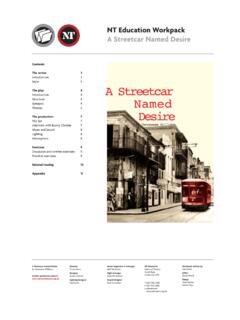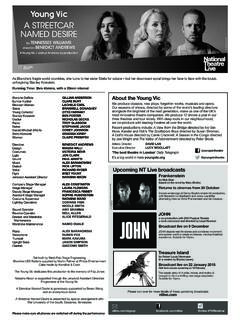Transcription of The Guide - Portland Center Stage
1 1A streetcar named DesireBy Tennessee WilliamsThe GuideA Theatergoer s ResourceEducation & Community Programs StaffKelsey TylerEducation & Community Programs DirectorClara-Liis HillierEducation & Community Programs Associate Eric Werner Education & Community Programs AssistantMatthew B. Zrebski Resident Teaching ArtistResource Guide ContributorsBenjamin Fainstein Literary ManagerMary Blair Production Dramaturg & Literary AssociateClaudie Jean FisherPublic Relations and Publications ManagerMikey MannGraphic DesignerTable of ContentsFrom the Director .. 2 Characters and Cast List .. 3A Conversation with Dramaturg Barbara Hort, .. 4 Paper Moons and Plastic Theater:the Enduring Vitality of a streetcar named desire .. 5 Behind the Scenes Facts .. 6 Vision and Craft: a Glance at the Compositionof a streetcar named desire .. 7 Additional Links .. 6 Curriculum ..9-11 PCS s 2015 16 Education & Community Programs are generously supported by:PCS s education programs are supported in part by a grant from the Oregon Arts Commission and the National Endowment for the additional support fromCraig & Y.
2 Lynne Johnston Holzman FoundationMentor Graphics FoundationAutzen Foundationand other generous mind sees an objectThe mind desires the objectThe object is out of reachAnger arisesThis truth about the fundamental nature of the mind has been articulated by spiritual teachers from the East for a millennia. In Tennessee Williams world, desire is an elemental force that sweeps away everything in its and Stanley both contain enormous rivers of desire . Neither has an outlet large enough to fully or safely give expression to that force. Both were born to dominate. And they fi nd themselves thrust together in a two-room apartment, in the sweaty, noisy, over-ripe and un-airconditioned world that is New Orleans in the summer. Maybe things will work out smoothly, but ..By the time Williams wrote streetcar sitting in his apartment in the French Quarter his beloved sister, Rose, had been in a mental institution for over a decade.
3 A girl of delicate sensibilities, she had begun having psychotic episodes of an overtly sexual nature in her late teens. For her mother, the severely puritanical and passive-aggressive Edwina, the episodes felt like a personal assault. For her combustible and deeply frustrated father, C. C., they were a source of complete baffl Tennessee, Rose s unraveling proved a source of sheer terror. Here, the one person (besides his beloved grandfather) he had most felt a connection to through his youth, the one person he felt actually understood him, had come completely unhinged. Surely that fate lay in store for terror haunted Williams steps every moment of his life. Three years prior to sitting down to write streetcar , after a particularly offensive and violent episode with Rose, Williams mother approved a frontal lobotomy for his sister. A head operation, she called natural restlessness compounded.
4 He drank too much, he couldn t stay in one place for more than a few months, he slept with too many people. The only solace, the only outlet that allowed his demons to fi nd some satisfaction, some form of quiet, was writing. Sitting at the typewriter he entered another world. No matter how late he d been out the night before, no matter how much he d had to drink, the fi ngers hit the keys of the typewriter, and another world emerged. He often didn t exit that world until six or eight hours revisit a play like streetcar because there is something fundamental about the truth it excavates. Somethingthrilling about the power it continues to ColemanFrom the Director2A Doctor / Ensemble (played by David Bodin)A Mexican Woman/ A Nurse/Ensemble (played by Sofia May-Cuxim)Mitch (played by Keith Eric Chappelle*)Stanley (played by Demetrius Grosse*)Stella (played by Kristen Adele*)Eunice (played by Dana Millican*)Blanche (played by Deidrie Henry*)Creola (played by Anya Pearson)Pablo (played by Gilberto Martin del Campo*)Steve (played by Bobby Bermea*)A Young Man/ A Vendor/Ensemble (played by Blake Stone)
5 Characters3In order of appearance*Member of Actors Equity Association, the Union of Professional Actors and Stage Managers in the United Conversation with Dramaturg Barbara Hort, have a very unique opportunity in the PCS rehearsal room whenever Chris Coleman directs, the benefits and wisdom of Production Dramaturg Barbara Hort, She shares her insight and experiences to help actors climb into the characters and provide information to help them explore the realistic beings we later find onstage. Barbara Hort first joined Chris Coleman in the rehearsal room for his production of Sweeney Todd. She sits in on rehearsals, advises in early table work with the cast and designers, and discusses the personalities of the characters assembled in that script. Barbara is present during rehearsals to help advise on how trauma, mental illness, personalities show themselves in realistic beings so the actors and Chris Coleman can take and process that knowledge and research and see how it might apply to their artistic interpretation.
6 In this particular production of a streetcar named desire , Barbara discussed the character of Blanche and how trauma has influenced the writing and creation of this character. She shared background history of schizophrenia, PTSD, and what they could look like in an adult and how they manifest themselves in times of high emotional stress, such as the plot of Moons and Plastic Theater: the Enduring Vitality of A streetcar named DesireBy PCS Literary Manager Benjamin FainsteinWhen a streetcar named desire premiered in 1947, Americans were working to reestablish normalcy amid the lingering dread of nuclear warfare. Despite burgeoning postwar prosperity, Depression-era economic anxiety persisted. The country was catching its breath and renewing its confidence after decades of tumult and loss. Veterans, like the men of streetcar , were returning to civilian life, hungry for opportunity.
7 Traditional gender roles were slowly shifting as a result of the millions of jobs created for women during the war. In the Deep South, the effete ruling class saw less-affluent citizens gunning to supplant them through hard work and sheer force of will. The poetic bravura and moral incertitude of streetcar , driven by an engine of robust sexuality, theatricalized the evolving American landscape. Williams gave theatergoers an explosion of immediacy unmatched by the musical comedies at other Broadway houses. The pervasive sense of instability rippling through the play hit close to home, and few sparring partners have maintained the legendary status of Blanche DuBois and Stanley Blanche first mentions her family s genteel Mississippi plantation Belle Reve (French for beautiful dream ), her neighbor Eunice remarks that a place like that must be awful hard to keep up. These words prove ominous, and Blanche s world of romantic illusions begins to crumble.
8 As she vies with Stanley for the affection of her sister Stella, Blanche s secrets are exposed and her identity dismantled. With the name Belle Reve, Tennessee Williams subtly forecasts this gathering storm: In French, the feminine adjective belle does not agree with r ve, a masculine noun. This discrepancy suggests that the plantation was likely christened Belle Rive (a feminine noun meaning shore ) before colloquial pronunciation eroded it to r ve. Scholar Felicia Hardison Londr links this linguistic slippage to the whole of Blanche s tragedy, writing that what had been a solid shore is now but an evanescent dream of lost splendor. [1]Before streetcar confirmed him as one of America s most artful playwrights, Tennessee Williams was best known for his elegiac coming-of-age drama The Glass Menagerie, an innovative memory play structured around flashbacks conjured by its narrator, Tom Wingfield.
9 In his notes on that play, Williams expresses a craving for a theater that is more atmospheric than realistic. With streetcar , Williams hit his mark. In The Glass Menagerie, the shifts between realistic and expressionistic modes are self-conscious and coolheaded, punctuated by Tom s direct addresses between scenes. The temperature of streetcar , in contrast, is scorching. Williams dialogue darts from soaring lyricism to gritty slang, and he fuses the planes of poetry and reality. In doing so, he grants symbolic significance to each element of the storytelling, from color and shadow to music, weather and architecture. The play adheres to his goal of a plastic theater that does not eschew its responsibility of dealing with reality, but through consummate theatricality provides a penetrating and vivid expression of things as they are. In streetcar , as in other plays, Tennessee Williams scavenged his personal life for dramatic substance.
10 Two of his iconic thematic obsessions are the repercussions of suppressed sexual desire and the challenges faced by people living with mental illness. His relationship with his beloved sister, Rose, was forever altered after she was institutionalized following a frontal lobotomy intended to treat her schizophrenia. Tennessee harbored a lifelong grief over Rose s fate while simultaneously struggling with his own mental health, addictions, and the stigma against homosexuality. Williams conjured Blanche DuBois, a fictional vessel through whom he could explore the potentially catastrophic consequences of these issues. He then plunged Blanche into a New Orleans that is both authentic and mythic, complicating the clash of reality and reverie that rages within and around her. Williams rendering of the city he knew so well provides a lush backdrop of sweltering heat, cultural fusion, incessant music, and a maddening lack of privacy.










